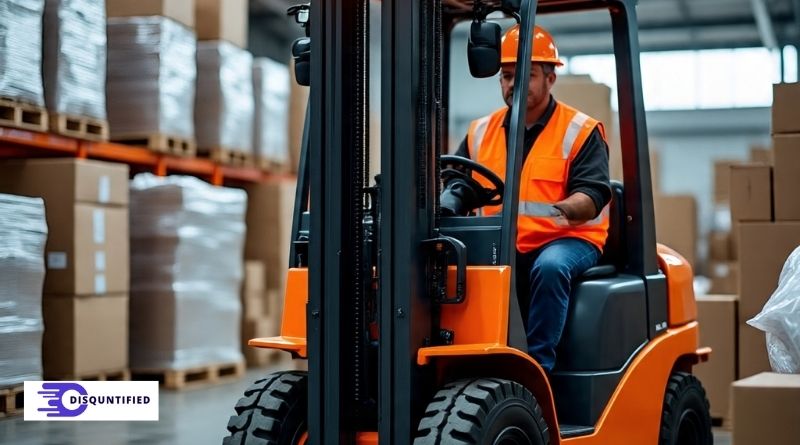What Is a Busy Work Environment?
Busy workplaces like warehouses, distribution centers, and construction sites are marked by rapid movement, intersecting foot and vehicle traffic, and frequent task changes. These conditions require high awareness and strong safety measures. Knowing who shares your workspace and expecting changing workloads can prevent mishaps. Businesses prioritizing foundational forklift training for their operators are better positioned to maintain workplace safety amidst the organized chaos that defines such environments.
A busy environment with narrow aisles, high shelves, loading docks, and multiple equipment increases congestion and blind spots, raising incident risks without proper training and safety measures. Clear communication, visibility, and reinforced safety are essential in these high-traffic areas.
Common Hazards Operators Face
Forklift operators face unique risks in busy environments, notably pedestrian collisions where workers and operators share space. Limited visibility from tight corners and obstructions hampers hazard detection. Additional dangers include falling objects, spills causing slippery floors, and unsafe load handling. According to OSHA forklift safety guidelines, more than 7,000 non-fatal forklift-related injuries are reported each year in the United States, many resulting from operator error or unsafe workplace conditions. Identifying hazards lets employers and workers prevent common workplace accidents. Besides routine hazards, operators may face poorly marked paths, poor lighting, and unexpected obstacles. Brief lapses in awareness during busy hours can cause damage and injuries. Recognizing these risks is key to developing effective safety protocols.
Core Safety Practices for Forklift Operators
Essential safety practices protect both forklift operators and their co-workers. Implementing daily forklift inspections—checking tires, brakes, warning lights, and fluid levels—reduces the risk of mechanical failure. Operators must be vigilant about speed regulations, particularly in congested spaces, and use the horn at intersections, blind spots, or when exiting an aisle. Wearing high-visibility vests and complying with posted load capacities are standard operating procedures. Many companies use checklists and visible reminders to keep safety in focus. Separating pedestrian zones from forklift traffic reduces collisions. Making these practices routine not only decreases accidents but also boosts efficiency.
Importance of Ongoing Training
Continuous learning and regulatory compliance are at the core of warehouse safety. Regular refresher courses, safety drills, and operational skill assessments ensure operators stay current on best practices, new equipment, and evolving safety guidelines. These ongoing educational initiatives foster a proactive mindset and minimize complacency, which can lead to dangerous shortcuts or outdated habits. According to Safety+Health Magazine, organizations with robust, ongoing training programs report lower accident rates and improved safety records. Training should always be tailored to the specific environment and address the challenges unique to high-traffic areas.
Developing a Culture of Safety
True workplace safety extends beyond formal training; it becomes a shared value embedded within the company’s culture. Management plays a critical role in modeling safe behaviors, encouraging open communication, and taking seriously every report of a near miss or unsafe practice. Recognizing and rewarding safe behaviors, hosting regular safety meetings, and supporting peer-to-peer feedback can transform safety from a box-ticking exercise into a way of life. When both staff and leadership prioritize safety, adherence to procedures becomes the norm, not the exception. This shift from individual responsibility to a collaborative culture significantly reduces the risk of accidents, especially during hectic periods or seasonal surges.
Role of Technology in Enhancing Safety
- Telematics: Modern telematics systems monitor forklift usage, operator speed, and compliance with safety guidelines in real-time, enabling timely corrective action.
- Proximity warning systems: These devices alert both drivers and pedestrians when a forklift is nearby, helping prevent collisions in high-traffic or limited-visibility areas.
- Wearable technology: Innovative wearables can detect sudden movements or potential crashes, broadcasting alarms to all parties at risk.
Forward-thinking companies are now leveraging these solutions to supplement traditional safety training and protocols. Embracing new technology increases not only the physical safety within the facility but also reinforces a broader, tech-savvy culture of continuous improvement.
Conclusion
Prioritizing safe forklift operation in high-traffic workplaces is more than a compliance requirement—it’s a commitment to protecting lives and ensuring smooth business flow. By following clear safety protocols, maintaining equipment properly, and fostering awareness among both operators and pedestrians, companies can significantly reduce risks. Every safe lift, turn, and stop contributes to a culture where efficiency and safety work hand in hand. Ultimately, a workplace that prioritizes safety isn’t just more productive—it’s also more resilient, trusted, and well-equipped for long-term success.

